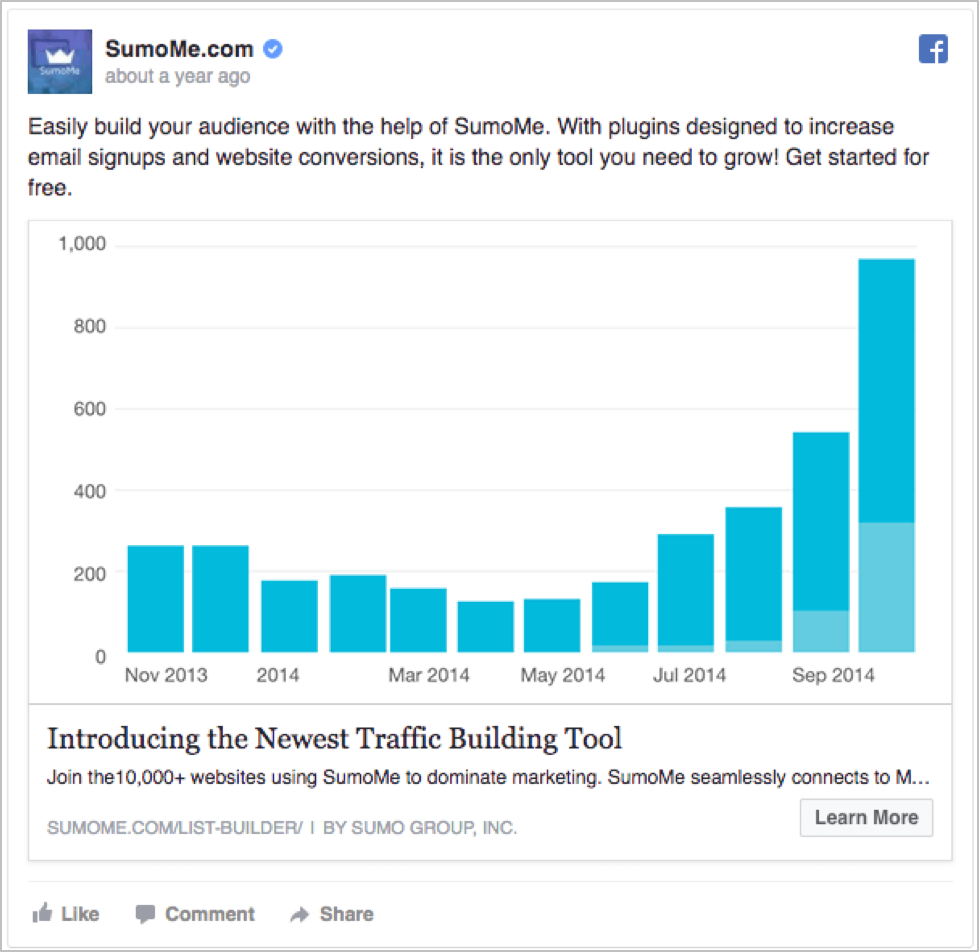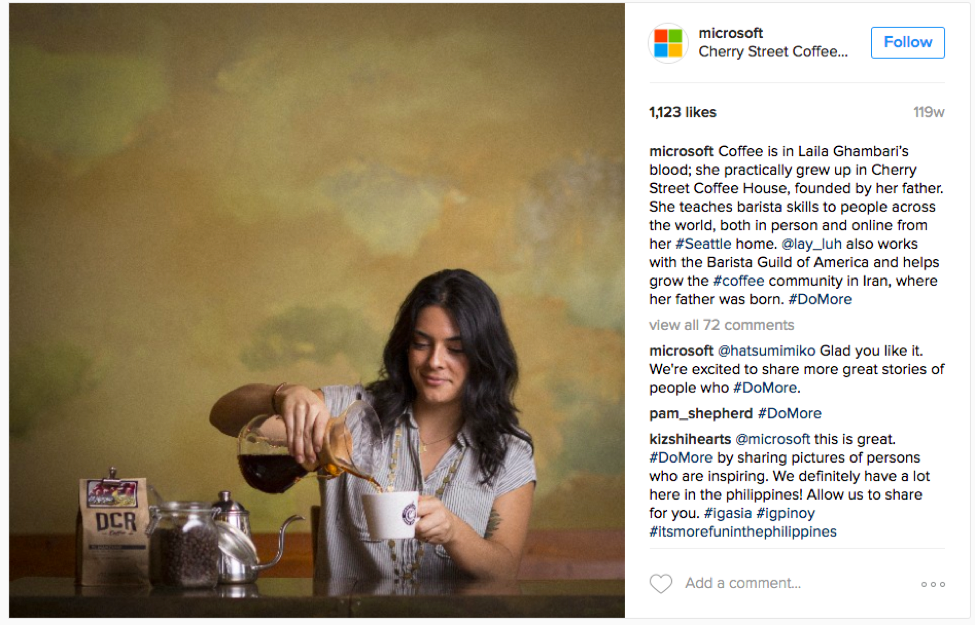50 milliseconds is all it takes.
Literally the blink of an eye.
That’s how quickly someone forms a first impression online, according to one study. And 94% of the time it comes down to your design.
Two problems with that:
2. 86% of people will completely ignore any image that even remotely resembles an ad.
Let’s recap. Design is what people notice first. Your design is competing with millions (and billions) of other alternatives. And it needs to avoid looking like an ad at all costs.
So, no pressure.
Thankfully, there is a solution. The best part is that you don’t need to be ultra creative, either.
Others are already paving the way. You just need to figure out who’s social media strategy leading the charge, and successfully reverse-engineer their approach.
Here’s how seven top companies expertly use visuals in their social media strategy to skyrocket their growth.
1. Spearmint Love
1. Spearmint Love
Kid’s fashion brand Spearmint Love is clearly doing something right with their visual social media strategy.
What originally started as a blog has quickly turned into an ecommerce powerhouse known for its stylized images–with 991% year over year growth!
Spearmint Love owner’s, husband and wife duo Shari and John Lott, built a pretty substantial following on a $0 online advertising budget, simply posting quality product photos on their Instagram account (amassing 105,000 followers).
But then they put some skin in the game, and started investing in Facebook ads. Using Facebook Insights, Lott broke his customers down into “cohorts” based on when they first bought the product.
This helped him identify patterns and behaviors of the Spearmint Love customer. (Read: he can better pinpoint what the customer wants and when they want it.)
Spearmint Love has since increased their advertising investment, and the uber-targeted strategy is becoming uber-profitable too–their low cost per customer acquisition of only $5 means they’re seeing a return by 5-10x. And they’ve increased sales to $1.5 million in 2016 (up from $150,000 just a year before.)
“The tremendous growth we’ve experienced is directly related to Facebook ads,” John Lott said. “The business operated on zero paid advertising before this point, but once we implemented our Facebook ad strategy, it just took off.”
Spearmint Love’s cohort strategy makes targeting their customers more of a science, but the art of their photography plays a big role, too. Shari takes enticing, I-have-to-have-that-baby-romper style photos that are a big part of the brands appeal.
“I put up a photo of not just a shirt or shoes, but of an entire outfit,” she said. “And moms will come back to the site and buy everything in that picture.”
But not all companies have that automatic artistic eye, or the big budget for high-quality photography. For brands just amping up their photo game, BigCommerce has a few DIY tips for even the most fledgling photographer to create stunning product photography for social:
1. Get the right equipment: buy an affordable DSLR, or use your trusty old iPhone with free photo apps like VSOCam.
2. Get the lighting right: play with backdrops that make your product pop and invest in some lights.
3. Test before you shoot: work with the setting, the lighting, and spacing before you start taking the real shots.
5. Practice: your first photo shoot might not get Annie Leibovitz’s attention. Keep at it.
2. Try the World
Monthly subscription boxes are all the rage. Which means they’re not unique. Which makes standing out difficult.
Try the World combines the allure of a food delivery service and a surprise at your door every 30 days, and uses imagery to get customers hooked.
Just by looking at the ad/photo, viewers can almost experience the physical product. They want to reach out and touch it (and then, hopefully, buy it).
Literally, there are hands grabbing and handling the products.
A Wall Street Journal article claims that the feeling of excitement lasts for 20 minutes. Give them a good reason to buy the product and they’ll need way less than 20 minutes.
KlientBoost notes two things that Try the World gets right: an engaging picture that shows the goods at the “most exciting moment of its lifecycle,” and an offer for freebies.
And who doesn’t like a freebie?
3. Kinsta
That goldfish you won at a carnival as a child?
It had the attention span of nine seconds.
Now compare that to a recent Microsoft Corps study, which found that your fishbowl friend now outranks you in the focus department.
You can only keep concentration for eight seconds.
You should get two takeaways from this. First, we should be ashamed of ourselves. Second, your brand’s social media needs to be heavy on the visuals.
WordPress host Kinsta goes all visual, basically eliminating any type of text content in their social images. They’ve found this works better for their brand.
They go heavy on graphics and icons. Then they put them on a patterned background from Hero Patterns, and make it look nice and pretty in Affinity Designer (this one’s gonna cost you). The image is then edited for size for all the usual suspects: Twitter, Facebook, etc.
4. SumoMe
Facts tell, stories sell. And a picture is worth a thousand words.
Anyone who doesn’t believe those two clichés should feast their eyes on this:
SumoMe nails several things in the same ad:
1. First, that graph. The giant, skyrocketing results. And the “before-and-after” feel that serves infomercials so well.
2. Next, social proof. This ads from a few years ago, but if their product works for “10,000+ websites,” it’s gonna work for you, too.
3. Last but not least, they use power words like “Introducing” and “Newest,” which are among the most influential words you can use.
Fast forward a few years and SumoMe has grown from 10,000+ websites to over 175,000 websites. (That’s a big jump.)
But the strategy and social images are expertly repurposed (when it ain’t broke…). So the same underlying principles but updated look and feel and stats.
All of the same ingredients are here. The growth example and social proof immediately resonate emotionally with potential customers.
And for extra credit, they use proper CTA’s, like “Sign-Up” on Facebook, that receives a 14.5% higher conversion rate.
5. Unbounce
Remember that blink and you miss it attention span of humans?
Unbounce does. The landing page creator knows that you probably aren’t reading the text in their posts (are you even reading this right now??) so they put their site’s process into a handy dandy little visual.
A Columbia University study found that 59% of people never even fully read the headline before sharing a post. Unbounce knows they need to cater to a quick audience, and give them the goods in a colorful package to increase conversions.
The ad is also heavy on the icons, which Kissmetrics says is good for drawing in the attention of the viewer and helping them get around the site.
Not only can people digest visuals more quickly (we only have eight seconds!), but they are more likely to remember information given to them that way. If you tell a person something, they will probably only remember 10% of it three days later. But, if you show it to them, they will retain closer to 65%.
That kind of staying power is important.
6. UNIQLO
Japanese clothing company UNIQLO took their marketing visuals high-tech when they started their “fast-moving” image campaign that showed customers quick-paced photos online that each provided a unique product code.
Customers could use the code online to redeem a free product sample.
If a tweet comes with an image, it is 150% more likely to be retweeted than its picture-less counterpart. If an article has a picture every 100 words or so, it is twice as likely to be shared on social channels.
So let’s just put this graph showing that Facebook posts with pictures receive 2.3 times more engagement right here:
It should be unsurprising that UNIQLO’s highly-engaging campaign was a hit with online sharing, too. They received 1.3 million video views and 25,000 new signups for their newsletter. The company got 35,000 new customers from this campaign alone!
7. Microsoft
When you hear “Microsoft,” you’re probably not thinking “social.” Or “visuals” for that matter.
So it might sound a little strange that the company’s Instagram account is focused on people.
Microsoft started their account in 2014, and ever since have used it to engage their customers with posts of the people behind the product. How do they integrate the product into their everyday lives? How does it help them achieve their goals? How does Microsoft help them #DoMore?
This approach has helped the company collect more than one million followers, and provides customers the perfect opportunity to feel connected to the brand. This builds better relationships with customers and leaves Microsoft with a treasure trove of user-generated content.
Conclusion
We don’t have time. And we don’t have the patience when faced with an onslaught of never-ending content. So we scan.
Your social headline might (key word here) stick out. If you’re extremely good, lucky, or click baity. But otherwise, it’s your image that does the heavy lifting.
The first thing people notice, form an impression or expectation, and click through to see more (or not).
Fortunately, you don’t have to be a graphic design rockstar. You just need to use the tools and tricks of the trade that the best of the best are using.
That includes everything from setting up your online DIY photography studio for product shots, to highlighting the results your product delivers, visually outlining your process, incorporating user-generated content, and even relying on affordable, easy-to-use tools.














